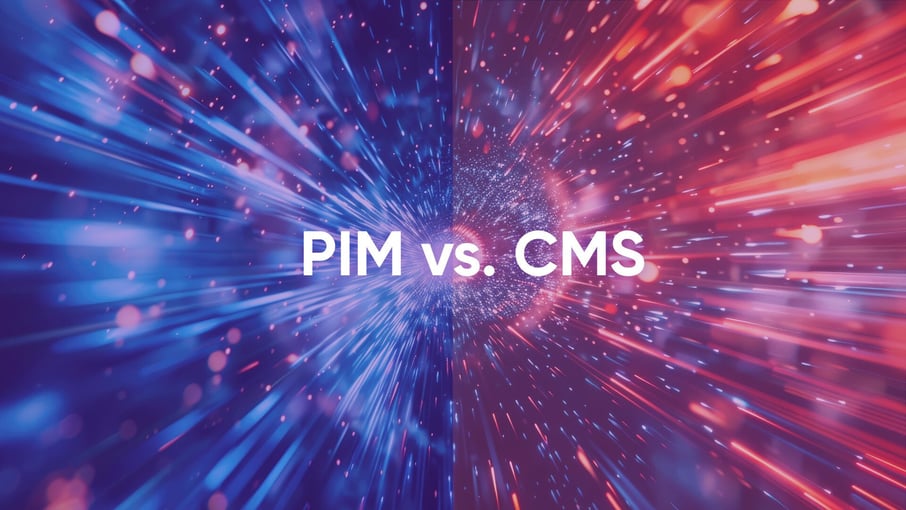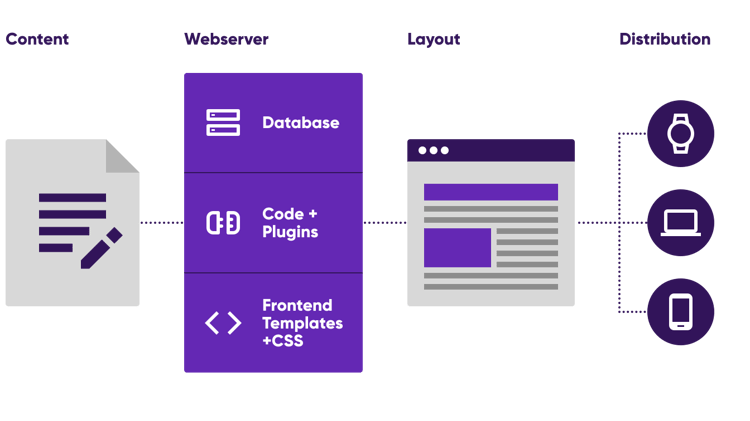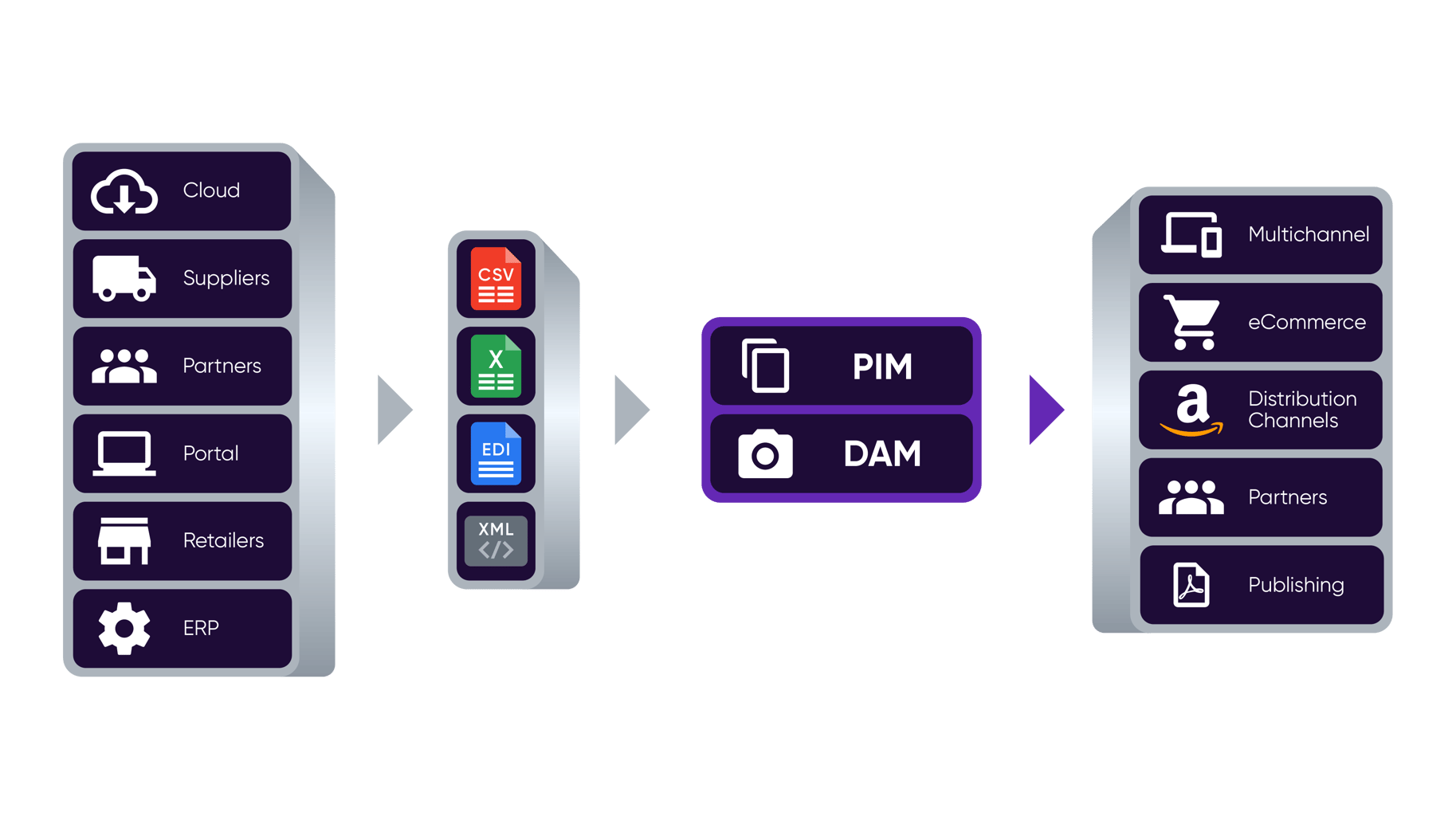
The proliferation of commerce channels is driving the need for a well-defined, organized, and coordinated product data and web content management strategy. However, enterprises, sometimes, are in a dilemma to opt for the appropriate solution for product data management out of various alternatives. This insight will help you choose and apply the right solution for gaining maximum benefit from product data and delivering engaging digital experiences.
Overview of CMS and PIM
1. Web Content
Web content involves textual, audio, and visual content which is published on web pages to engage readers and prospects. It may also include elements like animations, graphics, GIFs, and more. Web content is now part of the steady state for all types of businesses.
2. Product Data
Product data, also called product information, is a uniform set of identifiers and attributes that uniquely describes each product. Product data is generally structured and managed in an easy-to-use and easy-to-read format.
What is a Content Management System (CMS)?
According to Gartner, content management systems comprise a set of templates, procedures and standard format software that enables marketers and their proxies (e.g., webmasters) to produce and manage text, graphics, pictures, audio and video for use in Web landing pages, blogs, document repositories, campaigns or any marketing activity requiring single or multimedia content.
Today, the CMS scenario has changed significantly. Earlier, it was used for literal content management; it now contributes profoundly to execute digital experience strategies.
What is a Product Information Management System (PIM)?
Earlier, product data was used to accurately categorize, govern, track, and display printed product catalogs on physical stores. Now, a PIM system delivers a single, trusted source of product information for the purposes of engaging customers in a multichannel, multitouchpoint, multiexperience buying journey. Both B2C and B2B organizations for different verticals can benefit from the introduction of a PIM.
A PIM helps improve product data quality and for effective execution and engagement across channels. Moreover, it includes workflow management, digital asset management and multichannel publishing for faster time to market, improved data quality, reduced costs, and enhanced product experience.
Key Differences: CMS vs. PIM
1. Functional Differences Between CMS and PIM
CMS
Build any website
You can create any type of site you want—business site, blog, portfolio, and more to deliver contextualized, engaging experiences.
Empower digital marketing
Empower marketers in expanding and improving success with their digital marketing strategies.
Support digital commerce
Support multiple digital commerce scenarios with the ability to integrate, via APIs, with CRM, Analytics, marketing automation platforms, etc.
PIM
Buy-side implementation
PIM is used as a centralized system for product data, as received from suppliers via online data onboarding portals and/or global data syndication networks (GDSN)
Sell-side implementation
PIM acts as a single source to handle the enriched product data for catering different customer requirements. It includes publishing product data internally (within the organization) and seamlessly syndicating externally to customer-facing channels, e-commerce platforms, websites, and more.
2. Technical Differences Between CMS and PIM
Content Management System (CMS)

Product Information Management (PIM)

The Connection with Digital Commerce
1. CMS and Digital Commerce Connection
Level of Support: Basic
CMS can be used to execute the very basic level of product data management tasks, such as:
- Present simple product information for a very small product range.
- Inform and engage customers using simple product description and overviews.
- Integrate web content, via APIs, with digital commerce platforms such as blogging.
- Drive marketing campaigns on specific product data and product-related marketing content.
- Use content management as a component to build relationships with customers and prospects.
- Execute headless content-as-a-service capabilities for multiexperience content delivery.

2. PIM and Digital Commerce Connection
Level of Support: Advanced
PIM provides advanced features and benefits to enable marketers and product experts to streamline product data easily and optimize it for different channels to improve business performance.
- Perfect for managing large or complex product catalogs.
- Facilitate in managing global variations in products, currency, and language.
- Address complex data quality issues/errors to improve operational performance.
- Resolve data governance and stewardship issues impacting supply-chain relationships.
- Provide support for multiple channels and omnichannel (digital, physical, print).
- Optimize product feeds and automate product data syndication process.
- Give the ability to adopt new touchpoints and scale fast.
Explore the benefits of PIM eCommerce Integration
The Headless Momentum
1. What is Headless CMS?
Headless is a growing phenomenon in the CMS world. It decouples the content repository in modern content management technology stacks— simply separating the presentation layer (front-end) from the back-end. Headless CMS provides greater flexibility with APIs and the presentation layer in building custom front-end and publishing personalized content with granularity. It helps you ensure multiexperience content delivery beyond simple websites — such as mobile apps, progressive web apps (PWAs), single-page applications (SPAs), digital and voice assistants, smart devices, and more.
Explore Everything About Headless CMS
2. What is Headless PIM?
PIM solutions have evolved aggressively in the last few years. The transition of PIM solutions into headless PIM applications is steadily gaining momentum, where back-end components, such as servers and databases, and front-end components, like templates and webpages, are decoupled. This enables you to reuse back-end components for multiple front-end components using an API-driven approach. Using headless architecture, you can build front-end or presentation layers at a faster speed to meet exact UI requirements for diverse use cases.
Explore Everything About Headless PIM
How to Decide?
Identify the Gap with Business Case
WCM Business Case
If you want to put in place a basic digital commerce strategy, but you don’t have a direct-to-consumer channel, CMS can help. You can create product catalogs in a content management system (CMS) to support digital commerce.
PIM Business Case
PIM solutions are decisively built to consolidate and manage a single, trusted source of product information for the purposes of multichannel commerce and data exchange. Their capabilities support the end-to-end product data supply chain.
Gap
CMSes generally do not include advanced PIM capabilities and are therefore unable to govern, manage, and reuse product information and expanding SKUs efficiently, leading to weakened channel management and slower time-to-market.
Decide with Proof of Concept (POC)
Whether you choose a CMS or PIM system, you must identify the values that enhance your digital commerce programs. The ideal way to rigorously evaluate CMS and PIM solutions and their compatibility with your business processes is by using a proof of concept (POC) method.
First, start preparing your most critical business case and then churn out a sample dataset representing the width and breath of your product data. When you call different vendors for demos, ask them to configure the solution with your datasets and use cases. You should practically test the solution with your systems in your environment, using your usual processes and staff to avoid potential failures or unmet expectations before or during production. Based on the real scenarios and outcomes, you can zero on the right solution. The number of data sources and touchpoints and complexity of integrations will significantly impact implementation time and cost. So, choose your PIM vendor wisely.
Also read-
Central PIM & CMS: A Must-Have for F&B Companies to Scale Business
Deploy Right
You must carefully consider the deployment factors by determining how a solution will integrate into your existing IT ecosystem (here, we are taking a PIM solution perspective only). It would be best to identify and classify all source systems of product data and digital assets and the customer-facing or syndication channels that will consume the product data. Along with that, consider all the deployment options such as on-premises, cloud, and/or SaaS-based by keeping in mind both short-term and long-term business objectives. But, there is a need to assess the operational and business impact of a specific deployment option in terms of software stack management, quality control, agility, and TCO. You should deploy the PIM solution in phases and use pilot testing in production environments for reliable rollouts and higher success rates.
Also read-
How to Start with Cloud PIM: The Ultimate Guide
Common Myth: Can PIM and CMS Co-exist?
Many customers are skeptical about the co-existence of CMS and PIM solutions. The quick answer is, yes, they both can co-exist for various purposes without contradicting each other. Even both can play an essential role in digital product management, digital commerce, and CX improvement. You can unify data, content, and commerce in a single hub for a seamless digital experience. But it demands a strategic digital experience roadmap to integrate a PIM and CMS (these days also called DXP) into your current technology stack. Pimcore is one such platform that provides a seamless process for managing data (PIM/MDM), content (CMS/DXP), and commerce (Digital Commerce) with just a single platform— eliminating the need for using multiple technology platforms and reducing TCO.
Read more about Pimcore Data and Experience Management Platform


